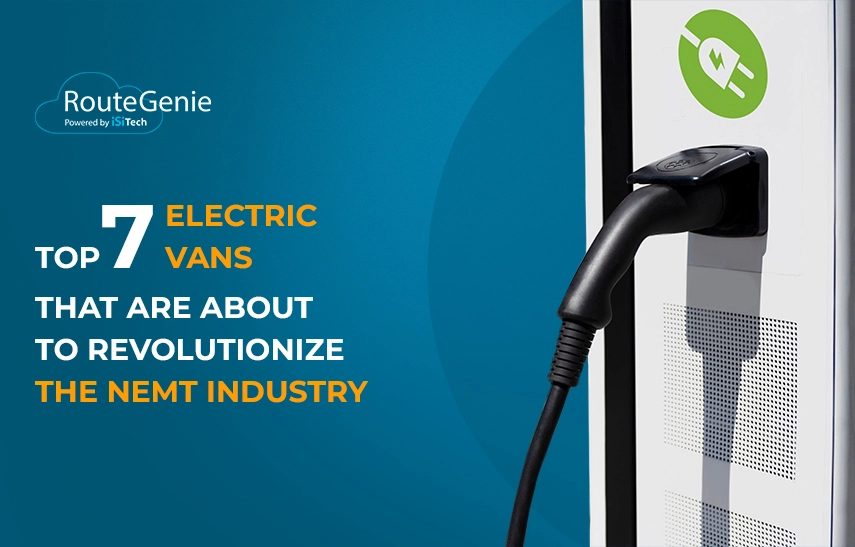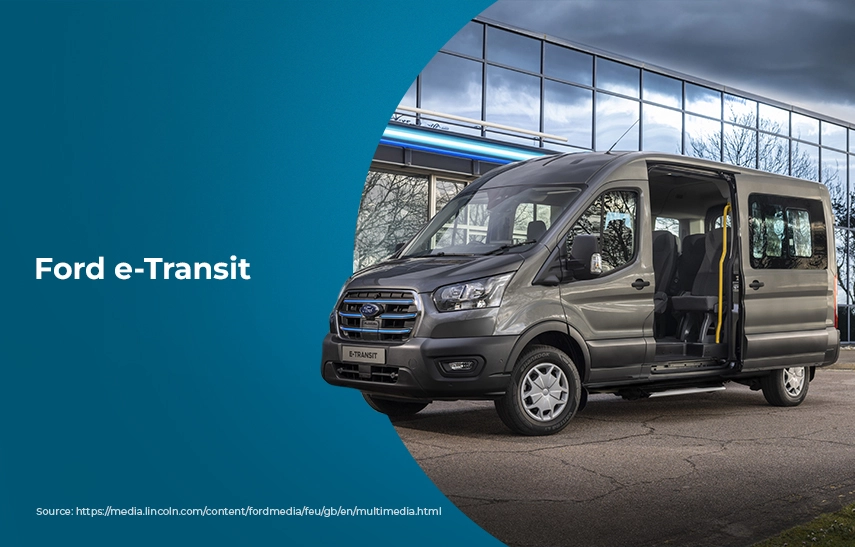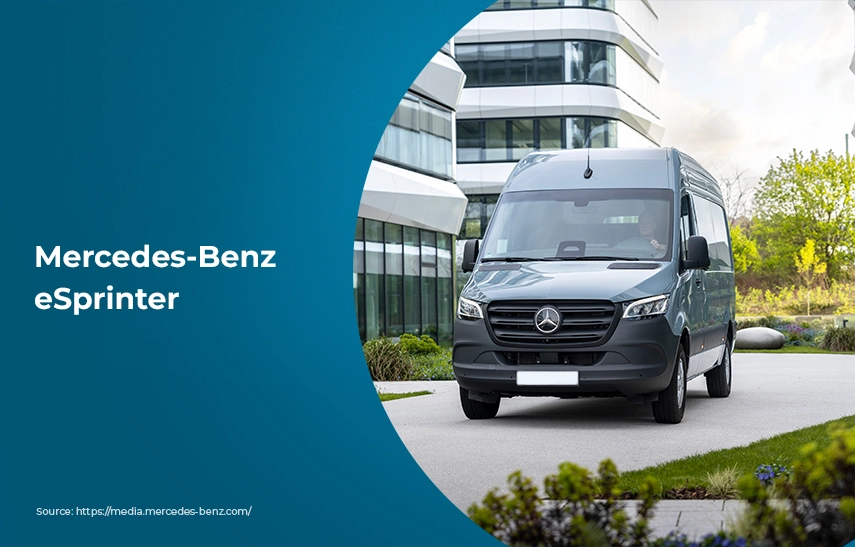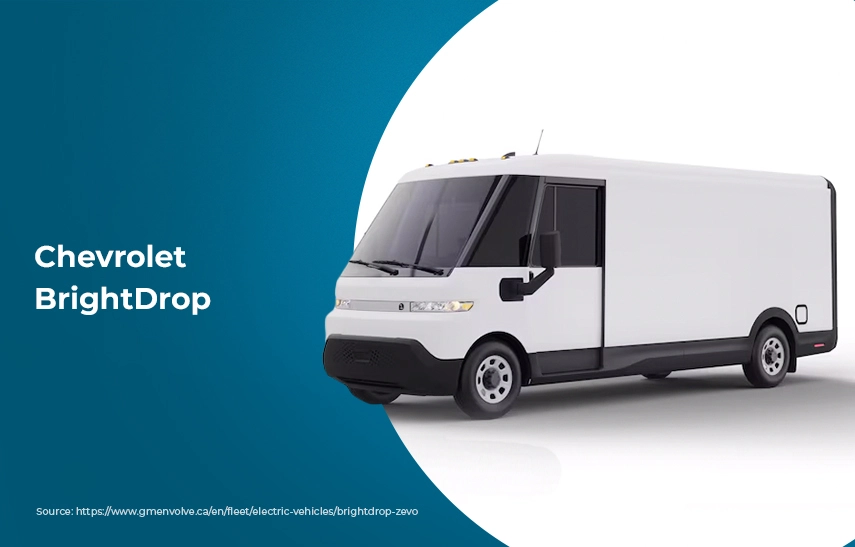Top 7 Electric Vans That Are About to Revolutionize the NEMT Industry

Contents:
- Introduction
- The Shift to Electric Is Still On Schedule
- Electric Van Models Leading the NEMT Revolution
- The Future of Electric Vans in Medical Transportation
- Conclusion
Introduction
The holy grail of non-emergency transportation is a reliable fleet of affordable vehicles with low fuel consumption and minimal maintenance requirements. The most popular NEMT vans like Dodge Grand Caravan, Toyota Sienna, Ford Transit, and Chevrolet Savanna do have an outstanding record complying with these criteria, but the time has come for them to yield to the new generation of vehicles.
Today we will be talking about the upcoming electric revolution within medical transportation, where traditional internal combustion vans will be replaced with electric vehicles. Starting in 2025, major carmakers will be introducing EV models to the US market, and very soon they will make their way to the non-emergency transportation fleets. In this article, we will list the best upcoming models with their technical specifications and prices. You should also learn about the benefits of adding electric vehicles to an NEMT fleet.
The Shift to Electric Is Still On Schedule
Despite the flashy news articles that have been circulating in the media about the failure of EVs, the electric revolution within the automotive world is well on its way. The International Energy Agency estimates that in just a dozen years, global EV sales have basically gone from zero all the way up to 18% of all total new car sales. In the United States, this figure is at a more modest 7.6%, but in countries like Norway where the government heavily incentivized adoption, the EV market share has reached an astonishing 82.4%.
The internal combustion engine technology has been quite stagnant during the last couple of decades. The ever-stricter emission requirements have demanded the implementation of more complicated ICE (internal combustion engine) technology. This led only to a slight increase in efficiency, yet the reliability of these mills dropped significantly, and maintenance became a pain.
At the same time, the EV tech has been making leaps in the improvement of battery chemistry, energy density, and overall design of vehicles. The EV prices have been decreasing, while driving ranges increasing. Their dependability ratings have been improving, and resale values leveling. According to the market research firm Gartner, “EVs will be cheaper to produce than gas-powered vehicles by 2027,” which will inevitably lead to the price parity between the two technologies and eventual lower prices for the cars powered by the positive charge.
Electric Van Models Leading the NEMT Revolution
If NEMT providers want to remain competitive, they will have to consider adding electric vehicles to their fleets. Medical transportation businesses always struggle with low profit margins, so they can greatly benefit from lowering the major expense categories like maintenance and fuel. It is widely known that electric vehicles possess these advantages, plus they are only getting more efficient, more reliable, and cheaper.
However, just like with ICE non-emergency medical transportation vans, it is important to make the right choice if you decide to electrify. Major OEM automakers are already offering electric vans in the USA after testing out the technology on European roads and highways. In fact, the majority of post-service operators in the Old World have tens of thousands of last-mile delivery vans with future contracts for many more. Additionally, there are some promising startups that bring unconventional designs to the table and expect to capitalize on the growing market.
We will provide you with a short list of worthy zero-emission van models suitable for the role of NEMT vehicles, while also listing their pricing, range parameters, and other technical features of these highly anticipated newcomers.
NOTE:
1) The typical daily mileage for NEMT rarely exceeds 150 miles, especially in highly urbanized areas where daily ranges can drop as low as 50-100 miles. With these numbers in mind, range anxiety should not be an issue.
2) To be used as NEMT vans, the majority of the upcoming lineup will have to be converted into a passenger vehicle, since for now, manufacturers are only offering cargo and chassis cab versions.
Ford e-Transit
 From $51,095
From $51,095 
Range: 159 mi 
The world’s most popular commercial gas van is finally getting an electric version that mirrors all of the capabilities of its internal combustion sibling. For now, only cutaway, chassis cab, and cargo van body styles are on offer. Additionally, there are three roof heights and two body lengths.
The 2024 model is juiced by an 89 kilowatt-hour battery storing 159 miles of range. It is equipped with an on-board charger that peaks at 176 kilowatts, meaning that 67 miles of range are restored in 15 minutes. The Ford e-Transit has a rear-wheel drive 266 horsepower single-motor powertrain that provides 317 pound-feet of instant torque. The max payload is 3880 pounds.
Standard features include the SYNC® 4 infotainment with a 12-inch display; the options list includes active driving assists, adaptive cruise control, a 360-degree camera with split view, and ProPower Onboard plug for all of your tools.
Ram Promaster EV
From $77,995 
Range: 162 mi 
Ram’s parent company Stellantis could not afford to fully cede the electric commercial van market to Ford, so they rushed in with an electric version of the Fiat Ducato, AKA Ram Promaster EV. On offer, there are two body styles, two heights, and an available roll-up door. Being a front-wheel-drive vehicle, this Ram continues to offer ideal loading height and flat floor, which would greatly benefit NEMT transportation providers.
Its motor produces 268 horsepower and 302 pound-feet of torque. With a battery pack of 110 kilowatt-hour rechargeable at 150 kilowatts, this Ram possesses quite significant range reserves of 162 miles even when fully loaded.
This is the most advanced and luxurious Promaster to date, offering an advanced Uconnect® 5 system with a 10-inch touchscreen and a digital dash with clear indication of the remaining range. The major downside of the Promaster EV is its price. At nearly seventy-eight grand, it is the most expensive model of them all, albeit offering a slightly longer range.
Mercedes-Benz eSprinter
 From $63,475
From $63,475 
Range: 150-206 mi 
For the first time in the U.S., customers can enhance their fleet’s sustainability with a battery-powered, emission-free van under the Mercedes-Benz brand. It offers the same versatility, load capacity, and advanced technologies as its gas-powered counterpart. Despite carrying the three-pointed star on its grille, this is not the most expensive offering on the market, but it is definitely among the most capable.
The electric Sprinter is sold in two configurations: a standard 177-inch wheelbase big-box high-roof van with the max cargo volume of 488 cubic feet, and a downsized 144-inch wheelbase with an 11.4-inch lower roof height. From 2025, the Sprinter will be offering some versatility in terms of the electric powertrain. Options are 134 or 201 horsepower motors and either 81 or 113-kWh batteries with 150 and 206 miles of range, respectively.
By opting for a Mercedes-Benz as their medical transport vehicle, drivers get access to the industry’s best safety systems, the most advanced MBUX infotainment, and a premium interior.
VW ID. Buzz
From $61,545 
Range: 234 mi 
Unlike the popular Volkswagen Multivan T7, the electric descendant of the Type 2 Microbus is making its way to the USA exclusively in the long wheelbase version. With its distinctively retro exterior design, the ID. Buzz offers a roomy interior with adaptable seating and three rows.
Buzz is based on the modular electric platform, and it is available in both rear- and all-wheel-drive versions, providing a range of up to 234 miles on a full charge. According to Volkswagen, when connected to a DC fast charger, the van can charge from 10% to 80% in just 30 minutes. The entry-level version is equipped with a rear-mounted electric motor generating 282 horsepower. A more powerful option includes a dual-motor setup with all-wheel drive, delivering 335 horsepower. Being a desiccated passenger vehicle, the ID. Buzz offers a cavernous interior with comfy seats, lots of amenities, driving aids, a 13-inch display, and a digital cluster.
If this van succeeds, chances are that VW will consider bringing to the US the electric full-size Volkswagen e-Crafter. Its latest modifications should have similar specifications to the abovementioned large panel vans.
Rivian EDV
$83,000 
Range: 201 mi 
When the Irvine-based electric car startup and the world’s largest internet retailer first announced their cooperation plan, it was all about exclusivity in exchange for a significant investment. Rivian pledged to deliver 100,000 units to Amazon prior to accepting orders from any other customer, but after about 10,000 vehicles had been delivered, the companies entered negotiations about ending the exclusivity clause of the contract.
Today, Rivian is allowed to produce EDVs for any willing customer. The model is based on the RCV (Rivian Commercial Vehicle) platform derived from the R1 platform that underpins Rivian’s electric pickup trucks and SUVs. It is built in three sizes: EDV/ECV-500/Delivery 500, EDV/ECV-700/Delivery 700, and EDV-900.
Being developed from the ground up on a dedicated EV platform, Rivian vans get a large 135 kilowatt-hour battery. The estimated EPA range reaches 201 miles, and recharge rates of 150 kilowatts are possible. The single Enduro motor makes 320 hp and 299 lb-ft, enabling the max payload up to 2,734 lbs.
To enhance the driver’s visibility, the van features an expanded windshield and integrated exterior cameras that provide a full view of the surroundings. Additionally, there is a large high-definition screen that allows one to control all of the systems, and Rivian offers one of the best electronic safety aids on the market.
Chevrolet BrightDrop (previously known as BrightDrop Zevo)
 $70,225
$70,225 
Range: 272 mi 
Out of the Big Three American carmakers, General Motors is the only one that chose to develop an EV van not under an existing moniker. At first, GM planned to build electric vans under its subsidiary BrightDrop, starting with the model named Zevo, but in 2024 the decision has been made to merge with Chevrolet and market it as a Chevrolet BrightDrop 400 and 600.
The General Motors Ultium architecture provides outstanding capabilities with 272 miles of combined City/Hwy range. It is an all-wheel-drive motor vehicle with up to 3580 pounds of payload, 614.7 cubic feet of cargo volume in the box, and plenty of power. The non-emergency medical transport van based on a Chevrolet BrightDrop will have built-in connectivity powered by OnStar and a full set of driving aids.
Chrysler Pacifica Plug-in Hybrid
$51,250 ($18,000 used) 
Range: 31 mi (520 mi/82 MPGe) 
For now, the Pacifica is the only small passenger van with an electric heart that is already being operated by NEMT businesses in the US. There is a caveat though: it is America’s only PHEV minivan, meaning that the vehicle is not fully electric. Instead, it combines the best features of both worlds. It gets unlimited range provided by a powerful V6 gasoline engine, has a manufacturer’s estimated all-electric 32-mile driving range, and therefore still qualifies for the maximum $7500 tax credit through the discount in Federal Income Tax.
In essence, this is a premium version of the industry’s favorite Dodge Grand Caravan, but unlike the Dodge, it is still in production. The Pacifica PHEV can provide most of the daily NEMT services on electricity alone, but if a longer trip is needed, the combined range reaches 520 miles with the fuel efficiency reaching 82 MPGe.
At the moment it is the most technological minivan in America, available both as a new model straight out of the dealership or could be purchased used in good condition.
The Future of Electric Vans in Medical Transportation
As mentioned before, electric vans are starting to dominate on the European market. Over there, EVs are represented across all van sizes and operated by the constantly growing number of businesses. It is logical to assume that American companies will be turning their attention towards the EV sector as well, especially taking into account the increasing variety of models, decreasing prices, and adequate ranges.
Non-emergency medical transportation companies will be among the major beneficiaries of the switch to electric vehicles. Electric models open up larger profit margins and provide extra comfort for the passengers, who can travel in a silent and smell-free cabin environment. The most prominent EV van models that already exist elsewhere and might be utilized by the US NEMT industry are as follows:
Ambulatory wheelchair-accessible electric vans: Ford e-Transit Connect, Nissan eNV200, Nissan Townstar EV, Volvo EM90.
Mid-size electric wheelchair vans: Mercedes-Benz e-Vito (Royal Mail UK), Ford e-Transit Custom, Toyota Proace City Electric.
Full-size electric stretcher vans: Arrival vans (UPS), StreetScooter (DHL), VW e-Crafter (operated by all major European delivery services and can fit a gurney).
With the growing numbers of electric vehicles on the roads, charging station networks will have to multiply a hundredfold. The electricity generation will have to increase by about 350 terrawatt-hours, which is about 10 percent upward growth if the target number for EVs is about 30% of market penetration. Moreover, the grid will have to be boosted to handle extra demand. Overall, these requirements sound like an achievable goal if both the government and the businesses work together.
Conclusion
From the way things are today, the future composition of NEMT fleets is likely to include both traditional gas vehicles plus a constantly growing number of electric vans. Here is a guide to the best NEMT medical transport vans for sale today.
In its quest for zero emissions, the government will do its best to decrease the carbon footprint, be it through incentives or new taxes. Therefore, for businesses that possess resources, seek innovation, intend to stay ADA compliant, and have high risk aversion, it becomes more and more beneficial to try out the transition to EVs. Such companies as Medstar Health, Veyo, and Electric Cab of North America have already begun seeking alternatives to traditional gasoline-powered vehicles. Major brokers promote sustainability by prioritizing partnerships with NEMT companies that integrate EVs into their fleets or even operate fully electric fleets.
The models that were presented in this article already possess adequate technical specifications to perform daily medical transportation activities, and they will only get better, especially if operated by a company that utilizes the industry’s best routing and scheduling software, like RouteGenie. Even though today the variety of EV vans is limited to only a handful of units in the US, consumers should expect the arrival of additional electric passenger and cargo vans because their versatility is much higher in other markets.
About the author

As RouteGenie's Marketing Director, Yurii gained deep knowledge in the NEMT industry. He is an expert in marketing, utilizing all marketing channels to build RouteGenie's brand and to make sure NEMT providers have access to powerful NEMT software that can boost their growth. Yurii shares his knowledge by writing content on topics related to marketing, and the healthcare industry: medical transportation, home care, and medical billing.
The author assumes no responsibility or liability for any errors or omissions in the content of this site. The information contained in this site is provided on an "as is" basis with no guarantees of completeness, accuracy, usefulness or timeliness.